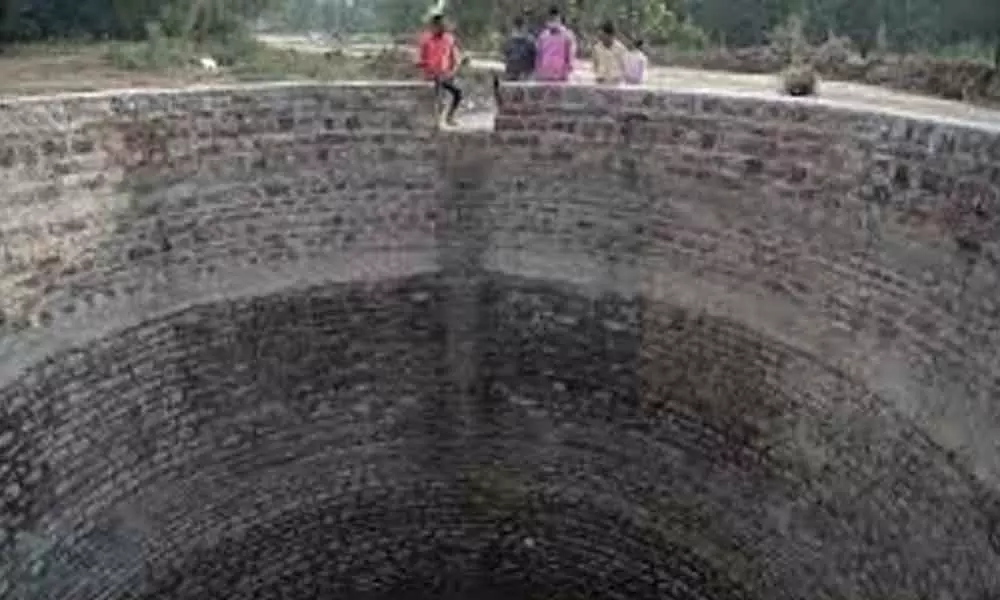Live
- They always want me to win, and now I feel lucky to have been offered a story like ‘Zebra’: Satyadev Kancharana
- ‘Democracy first, humanity first’: PM Modi in Guyana's parliament on two countries' similarities
- PKL Season 11: Telugu Titans register third straight win to top standings
- Is Pollution Contributing to Your COPD?
- NASA Unveils Underwater Robots for Exploring Jupiter's Moons
- Additional Central forces arrive in violence-hit Manipur
- AR Rahman and Saira Banu’s Divorce: Legal Insights into Common Issues in Bollywood Marriages
- 82.7 pc work completed in HPCL Rajasthan Refinery area: official
- Curfew relaxation extended in 5 Manipur districts on Friday
- Tab scam prompts Bengal govt to adopt caution over fund disbursement
Just In
Groundwater overuse posing serious threats


Groundwater overuse posing serious threats
As per the data for 2015 based on 15,165 locations in 32 States tested by the Central Ground Water Board (CGWB), groundwater has higher than permissible limits of Arsenic (697 locations), Fluoride (637 locations), Nitrate (2,015 locations), Iron (1,389 locations) and Salinity (587 locations)
New Delhi: The Comptroller and Auditor General (CAG) of India has pointed out that in the period between 2004 and 2017, the stage of extraction of ground water increased from 58 per cent to 63 per cent, and in 2017-18, the stage of extraction was higher than the national stage in 13 states/UTs with aquifer mapping completed barely for 52 per cent area.
The percentage of utilisation of ground water with respect to recharge is known as the stage of extraction of ground water. Pointing out that four States – Delhi, Haryana, Punjab and Rajasthan – had a stage of extraction of more than 100 per cent, indicating that extraction of groundwater has surpassed the recharge of groundwater in these states, the 'Report of Comptroller and Auditor General of India on Groundwater Management and Regulation: Union Government, Department of Water Resources, River Development & Ganga Rejuvenation' tabled in the Parliament also brought out the alarming fact that "at the district level, in 24 states/UTs, as many as 267 districts had stage of extraction more than 63 per cent, ranging from 64 per cent to 385 per cent".
The report contains the observations of the performance audit of groundwater management and regulation for the period 2013-18. Matters relating to the period subsequent to 2017-18 have also been included, wherever necessary. "The groundwater scenario in India is beset by challenges due to the competing needs of agriculture, industrialisation and the pressures of increasing population in the context of uncertain rainfall. Contamination and depletion of groundwater also leads to vulnerability of livelihoods, besides posing a serious health risk," the CAG report said.
During the period 2004 to 2017, the percentage of safe blocks decreased while the percentage of blocks categorised as semi-critical, critical and over-exploited steadily increased. As per the data for 2015 based on 15,165 locations in 32 states tested by the Central Ground Water Board (CGWB), groundwater had levels of contaminants higher than permissible limits of Arsenic (697 locations), Fluoride (637 locations), Nitrate (2,015 locations), Iron (1,389 locations) and Salinity (587 locations), it said.
The central sector scheme on Groundwater Management and Regulation was approved for implementation during the 12th plan period (2012-17) with an estimated cost of Rs 3,319 crore. Even when the scheme was continued during 2017-20 at an estimated cost of Rs 992 crore, against a budget estimate of Rs 2,349.48 crore for 2012-19, the actual expenditure under the scheme was just Rs 1,109.73 crore, the CAG report said.
But what is more worrying is that as against an area of 24.8 lakh sq km that was identified for aquifer mapping in the country, the CGWB covered only an area of 13 lakh sq km (52 per cent) as of September 2020. In its recommendations, the report suggested that the department may develop a strategy for expeditious completion of aquifer mapping and modelling of the identified area within a reasonable time period. It also suggested the CGWB may take suitable action to develop the web-based system for easy dissemination of information regarding aquifer mapping on priority basis. "The department may ensure proper coordination between CGWB and state governments for implementing the recommendations made in the national aquifer mapping project reports," the CAG report recommended.

© 2024 Hyderabad Media House Limited/The Hans India. All rights reserved. Powered by hocalwire.com






